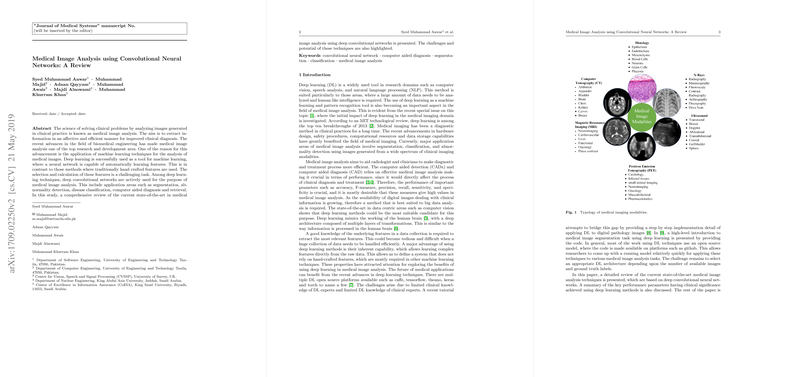Medical Image Analysis using Convolutional Neural Networks: A Detailed Review
The authors of the paper present a comprehensive survey of the current state-of-the-art in medical image analysis, emphasizing the role of deep convolutional neural networks (CNNs). This review is essential for understanding the growing landscape of deep learning applications in medical image segmentation, abnormality detection, disease classification, and computer-aided diagnosis (CAD).
Medical image analysis contributes notably to clinical diagnostics, facilitated by advances in biomedical engineering and machine learning. Deep learning, particularly CNNs, has emerged as a pivotal tool due to its ability to automatically learn complex features from raw data. This capacity contrasts sharply with traditional methods reliant on hand-crafted features, which often demand expert domain knowledge and are constrained by their feature selection process.
Challenges and Techniques
The review highlights multiple challenges in medical image analysis:
- Data Scarcity: Despite the abundance of medical images generated daily, labeled datasets remain limited. The paper discusses the use of data augmentation and transfer learning as effective strategies to counter this issue.
- 3D Data Utilization: Many medical images are volumetric, such as CT and MRI scans. Efficiently processing this 3D data requires innovative network architectures that can handle the additional complexity.
- Overfitting: The risk of overfitting on small datasets is mitigated by regularization techniques like dropout and batch normalization.
Detailed Architectural Insights
Deep learning's success in medical image analysis is attributed to various CNN architectures. Shown through methods like the U-Net, and its derivatives such as U-Net++ and W-Net, researchers have optimized network designs to better capture medical anomalies. These architectures use convolution, deconvolution, and skip connections for enhanced feature extraction and better retention of spatial information.
Application Areas
Segmentation
CNNs excel in image segmentation, an essential step for identifying structures and abnormalities within medical images. Methods like the InputCascade CNN and Deep Medic have demonstrated high performance metrics on datasets such as BRATS, indicating their potential efficacy in clinical settings.
Disease Classification
CNNs have also been impactful in disease classification. For instance, methods applied to ILD classification, using CT scans, have achieved up to 92.23% accuracy. This exemplifies the applicability of CNNs across varied medical conditions and imaging modalities.
Computer-Aided Diagnosis (CAD)
CAD systems benefit significantly from CNNs. By facilitating the automatic detection of diseases, these systems support radiologists in interpreting medical images, leading to more accurate diagnostics and treatment plans. The reviewed paper underlines CAD applications in detecting conditions such as thyroid nodules, lung diseases, and breast cancer, further solidifying the role of CNNs in enhancing clinical workflows.
Evaluation Metrics
Performance metrics for these CNN-based methods include accuracy, precision, recall, and F1-score. The paper provides mathematical formulations of these metrics, underscoring their importance in evaluating the efficacy of medical image analysis systems. Metrics like the Dice score are particularly highlighted for their relevance in segmentation tasks.
Future Directions and Limitations
The review points out the necessity for continued research to overcome present limitations:
- Computational Power: Training deep CNN models demands significant computational resources, which is a barrier for widespread implementation.
- Interpretability: The 'black box' nature of deep learning models remains a challenge, necessitating advancements in model interpretability for clinical acceptance.
- Noise and Anomalies: Medical images often suffer from noise and illumination problems. Pre-processing techniques are crucial in mitigating these issues to advance model robustness.
Conclusion
The paper compellingly argues that CNNs will continue to play an essential role in advancing medical image analysis, leading to improved CAD systems and better diagnostic accuracy. As the computational resources and architectures evolve, the prospects for deep learning in medical applications are promising, paving the way for future breakthroughs in medical diagnostics and treatment planning. The unified efforts of computer scientists and medical practitioners will be vital for harnessing the full potential of deep learning in healthcare.
